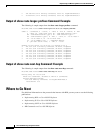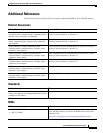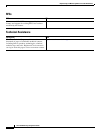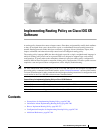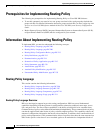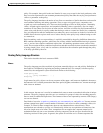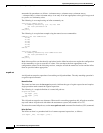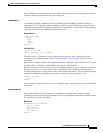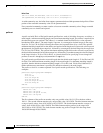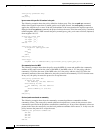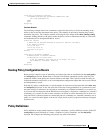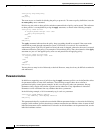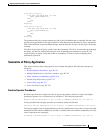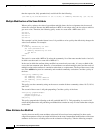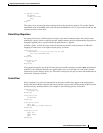
Implementing Routing Policy on Cisco IOS XR Software
Information About Implementing Routing Policy
RC-210
Cisco IOS XR Routing Configuration Guide
Inline Form
(RT:1.2.3.4:666, RT:1234:6667, SoO:1.2.3.4:777, SoO:45678:777)
(RT:$ipaddr:666, RT:1234:$tag, SoO:1.2.3.4:777, SoO:$tag2:777)
As with community sets, the inline form supports parameterization within parameterized policies. Either
portion of the extended community value can be parameterized.
Every extended community-set must contain at least one extended community value. Empty extended
community-sets are invalid and rejected.
prefix-set
A prefix-set holds IPv4 or IPv6 prefix match specifications, each of which has four parts: an address, a
mask length, a minimum matching length, and a maximum matching length. The address is required, but
the other three parts are optional. The address is a standard dotted-decimal IPv4 or colon-separated
hexadecimal IPv6 address. The mask length, if present, is a nonnegative decimal integer in the range
from 0 to 32 (0 to 128 for IPv6) following the address and separated from it by a slash. The optional
minimum matching length follows the address and optional mask length and is expressed as the keyword
ge (mnemonic for greater than or equal to), followed by a nonnegative decimal integer in the range from
0 to 32 (0 to 128 for IPv6). The optional maximum matching length follows the rest and is expressed by
the keyword le (mnemonic for less than or equal to), followed by yet another nonnegative decimal integer
in the range from 0 to 32 (0 to 128 for IPv6). A syntactic shortcut for specifying an exact length for
prefixes to match is the eq keyword (mnemonic for equal to).
If a prefix match specification has no mask length, then the default mask length is 32 for IPv4 and 128
for IPv6. The default minimum matching length is the mask length. If a minimum matching length is
specified, then the default maximum matching length is 32 for IPv4 and 128 for IPv6. Otherwise, if
neither minimum nor maximum is specified, the default maximum is the mask length.
The prefix-set itself is a comma-separated list of prefix match specifications. The following are
examples:
prefix-set legal-ipv4-prefix-examples
10.0.1.1,
10.0.2.0/24,
10.0.3.0/24 ge 28,
10.0.4.0/24 le 28,
10.0.5.0/24 ge 26 le 30,
10.0.6.0/24 eq 28
end-set
prefix-set legal-ipv6-prefix-examples
2001:0:0:1::/64,
2001:0:0:2::/64 ge 96,
2001:0:0:2::/64 ge 96 le 100,
2001:0:0:2::/64 eq 100
end-set
The first element of the prefix-set matches only one possible value, 10.0.1.1/32 or the host address
10.0.1.1. The second element matches only one possible value, 10.0.2.0/24. The third element matches
a range of prefix values, from 10.0.3.0/28 to 10.0.3.255/32. The fourth element matches a range of
values, from 10.0.4.0/24 to 10.0.4.240/28. The fifth element matches prefixes in the range from
10.0.5.0/26 to 10.0.5.252/30. The sixth element matches any prefix of length 28 in the range from
10.0.6.0/28 through 10.0.6.240/28.



